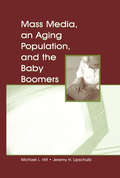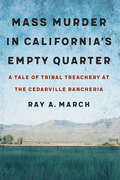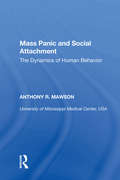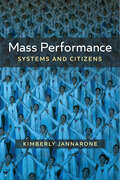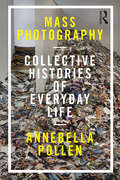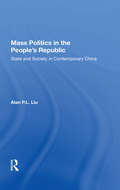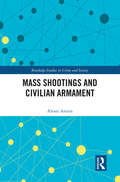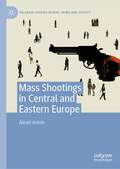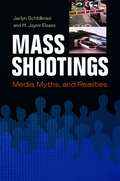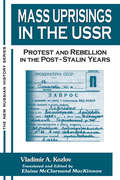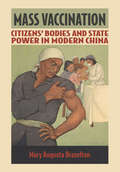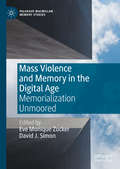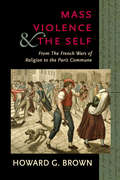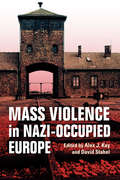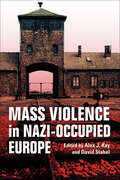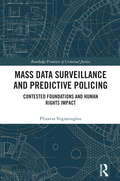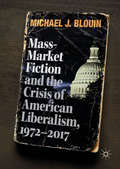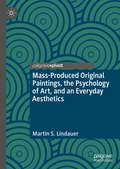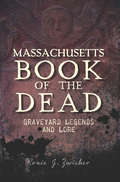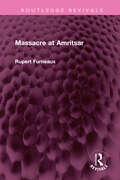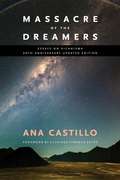- Table View
- List View
Mass Media, An Aging Population, and the Baby Boomers (Routledge Communication Series)
by Jeremy H. Lipschultz Michael L. HiltAs the oldest members of the baby boomer generation head into their retirement years, this demographic shift is having a substantial influence on uses of mass media, as well as the images portrayed in these media. Mass Media, An Aging Population, and the Baby Boomers provides a comprehensive examination of the relationship between media and aging issues, addressing mass media theory and practice as it relates to older Americans.Reviewing current research on communication and gerontology, authors Michael Hilt and Jeremy Lipschultz focus on aging baby boomers and their experiences with television, radio, print media, entertainment, advertising and public relations, along with the Internet and new media. They draw from studies about health and sexuality to understand views of aging, and present a view of older people as important players in the political process. Hilt and Lipschultz conclude the volume by addressing trends and making predictions related to baby boomers and mass media.Providing a timely and insightful examination of the linkage between mass media and aging issues, this volume will prove a valuable resource for scholars and students in media and gerontology. It is intended for use in coursework addressing such topics as mass communication and society, media and aging, media and public opinion, sociology, and social gerontology.
Mass Murder and Serial Murder: An Integrative Look
by Arnon EdelsteinWhile “Mass murder” refers to the murder of several people at the same time, "serial murder" describes several killings by the same perpetrator in a repetitive pattern. Usually these incidents count a high toll of victims and create significant anxiety in the public. Yet, the rate of finding murderers in these cases is relatively very low, especially in serial murders; that is if they are ever caught at all. Arnon Edelstein examines the various categories of mass murder and serial murder and suggests a new category: “mass-serial murder”. He presents and criticizes the most up-to-date research and theoretical literature in the field and suggests an integrative theoretical model. This groundbreaking volume is intended for criminologists, psychologists, sociologists, students, and readers who are interested in truly understanding the complicated aspects of this fascinating field of investigation.
Mass Murder in California's Empty Quarter: A Tale of Tribal Treachery at the Cedarville Rancheria
by Ray A. MarchMass Murder in California&’s Empty Quarter exposes a story of mass murder, a community&’s racism, and tribal treachery in a small Paiute tribe. On February 20, 2014, an unseasonably warm winter day for the little agriculture town of Alturas, California, Cherie Rhoades walked into the Cedarville Rancheria&’s Paiute tribal offices. In the space of nine minutes she killed four people and wounded two others using two 9mm semiautomatic handguns. In that time she slayed half of her immediate family and became only the second woman, and the first Native American woman, to commit mass murder in the United States. Ray A. March threads the story through the afternoon of the murders and explores the complex circumstances that led to it, including conditions of extreme economic disparity, privations resulting from tribal disenrollment, ineptness at the Bureau of Indian Affairs, and family dysfunction coupled with a possible undiagnosed mental illness. This account of the tragic murders and the deplorable conditions leading up to them shed light on the formidable challenges Native Americans face in the twenty-first century as they strive to govern themselves under the guise of U.S.-sanctioned sovereignty.
Mass Notification and Crisis Communications: Planning, Preparedness, and Systems
by Denise C. WalkerMass communication in the midst of a crisis must be done in a targeted and timely manner to mitigate the impact and ultimately save lives. Based on sound research, real-world case studies, and the author‘s own experiences, Mass Notification and Crisis Communications: Planning, Preparedness, and Systems helps emergency planning professionals create
Mass Panic and Social Attachment: The Dynamics of Human Behavior
by Anthony R. MawsonHow do humans behave when under threat of attack or disaster? How does the social context affect individual behavior? Anthony Mawson provides an illuminating examination of individual and collective behavior under conditions of stress and danger, in response to both natural and manmade threats and disasters. Opening with a question about the interpretation of "mass panic" in combat , the book gradually unfolds into a multidisciplinary analysis of the psychobiological basis of social relationships and the neural organization of motivation and emotion. Mawson provides a comprehensive review and synthesis of the mass panic and disaster literature and offers a social attachment model, that recognizes the fundamentally gregarious nature of human beings and the primacy of attachments. He argues that the typical response to threat and danger is neither fight nor flight, nor social breakdown, but increased affiliation and camaraderie. This book is unique in addressing the behavioral and social aspects of threat and disaster. It will appeal to social scientists across a range of disciplines, to public administrators, and to disaster and public health professionals.
Mass Performance: Systems and Citizens
by Kimberly JannaroneMass Performance: Systems and Citizens examines mass performance systems from the first major festival of the French Revolution through the democratic and socialist movements of the nationalizing nineteenth and twentieth centuries in Europe, to totalitarian communist and socialist regimes in the twentieth century, ending with contemporary North Korea. While other scholars have studied specific mass performances, this study synthesizes the phenomenon across centuries and countries, focusing on its systemization. Modern nations defining or redefining their identities not only organized mass performances, but also planned to make those performances a permanent component of nationhood. Kimberly Jannarone reveals that mass performance systems, including synchronized gymnastics to choreographed rallies, encapsulate ideals and debates within emerging nations about the relationship of citizens to each other and to their leaders, playing a generative and reflective role in the culture and politics of the modern era. Mass Performance analyzes the specifics of performance choreography and design, the organizational planning and thinking behind the systems, the material circumstances of each system’s emergence, and the broader intellectual milieu in which they developed. Although not a comprehensive study of such events, Jannarone’s analysis of the selected mass performance systems yields new theoretical perspectives on these phenomena, a central focus of her study being how political leaders find ways to create a physically coordinated mass body politic, even during times of hardship and war. By interpreting and historicizing mass assemblies of bodies, this study analyzes the choreographies and organizations that brought thousands of people together as an ensemble and kept them together in meaning-making motion.
Mass Photography: Collective Histories of Everyday Life (International Library Of Visual Culture Ser.)
by Annebella PollenWith increasingly accessible camera technology, crowdsourced public media projects abound like never before. Such projects often seek to secure a snapshot of a single day in order to establish communities and create visual time capsules for the future. Mass Photography: Collective Histories of Everyday Life assesses the potential of these popular moment-in-time projects by examining their current day prevalence and their historical predecessors. Through archival research and interviews with organisers and participants, it examines, for the first time, the vast photographic collections resulting from such projects, analysing their structures and systems, their aims and objectives, and their claims and promises. The central case study is the 55,000 photographs submitted to One Day for Life in 1987, which aimed, in its own time, to be ‘the biggest photographic event the world had ever seen’.
Mass Politics In The People's Republic: State And Society In Contemporary China
by Alan P.L. LiuExploring the crucial link between state and society in the People's Republic of China (PRC), this book analyzes the interaction between the Chinese Communist Party and the country's major social groups. It explores how public opinion contributes to a mass political culture in China.
Mass Shootings and Civilian Armament (Routledge Studies in Crime and Society)
by Alexei AnisinMass Shootings and Civilian Armament provides the first comprehensive multi-methodological analysis of the relationship between mass shootings and firearm purchases (as proxied by background checks) in the US on national level data from 1999-2020. Since 1994, the number of civilian-owned firearms in the US has doubled to around 398 million while the population only grew by 70 million. On average, mass shootings have occurred once every two weeks over the last decade which is a major factor behind why social scientists have started to ask whether mass shootings play a causative role in civilian decisions to purchase guns. Utilizing a multi-methodological approach featuring quantitative, comparative/configurational, and qualitative methods, this book puts forward a theoretical framework and argues that mass shootings do increase civilian armament, but that this repetitious effect is historically contingent, asymmetric, and non-linear. Particular types of mass shootings are hypothesized to have driven and continue to bring about increased levels of civilian firearm purchases through different pathways and combinations of variables – those that feature high fatality counts; arise in areas of cultural importance, are ideologically motivated. First, inquiry into background check data (1999-2020) and data on 213 mass shootings and attempted mass shootings is carried out to find out which shootings (as well as controls) are significantly correlated with background check increases. Second, the findings are utilized in a theoretically driven comparative configurational assessment to test if the noted theoretical pathways are associated with the outcome of increased post-shooting armament. Third, the empirical analyses are complimented by three case studies – the 2011 Gabrielle Giffords shooting (illustrative of the high fatality pathway), the 2012 Colorado movie theater shooting (illustrative of the cultural pathway), and the 2015 Charleston Church shooting (illustrative of the ideologically driven pathway). Interdisciplinary in nature, Mass Shootings and Civilian Armament will not only be of great interest to scholars of Criminology, but will also speak to sociologists, economists, public policy scholars, political scientists, historians, as well as cultural studies and American studies scholars.
Mass Shootings in Central and Eastern Europe (Palgrave Studies in Risk, Crime and Society)
by Alexei AnisinThis book examines mass shootings and attempted shootings that occurred across 16 countries in Central and Eastern Europe, known as post-communist states. This region of the world has been described by social scientists as possessing specific social, cultural, and political characteristics which may mean that mass shootings in this part of the world are driven by distinct causal factors in comparison to those in North America and elsewhere. This book explores trends and patterns that underpin cases in this under-explored region and tests whether Cumulative Strain Theory can account for mass shooting occurrences. It uses in-depth qualitative analysis to examine select case studies in one chapter, followed by a chapter which uses quantitative methods to identify trends across a wider set of cases and to test the theoretically-driven hypotheses. This data is then compared with data in the US. This book draws on a wide range of media, forensic and court reports and provides methodological insights and discussions of future trends including the potential incidental increase of mass shootings in these regions. It also engages in recent public policy debates pertaining to firearm ownership and regulation.
Mass Shootings: Media, Myths, and Realities (Crime, Media, and Popular Culture)
by Jaclyn Schildkraut H. Jaymi ElsassWhen a mass shooting happens, the news media is flooded with headlines and breaking information about the shooters, victims, and acts themselves. What is notably absent in the news reporting are any concrete details that serve to inform news consumers how prevalent these mass shootings really are (or are not, when considering crime statistics as a whole), what legitimate causes for concern are, and how likely an individual is to be involved in such an incident. Instead, these events often are used as catalysts for conversations about larger issues such as gun control and mental health care reform.
Mass Uprisings in the USSR: Protest and Rebellion in the Post-Stalin Years
by V. A. Kozlov Elaine McClarnandUntil recent times, incidents of mass unrest in the USSR were shrouded in official secrecy. Now this pioneering work by historian Vladimir A. Kozlov has opened up these hidden chapters of Soviet history. It details an astonishing variety of widespread mass protest in the post-Stalin period, including workers' strikes, urban riots, ethnic and religious confrontations, and soldiers' insurrections. Kozlov has drawn on exhaustive research in police, procuracy, KGB, and Party archives to recreate the violent major uprisings described in this volume. He traces the historical context and the sequence of events leading up to each mass protest, explores the demographic and psychological dynamics of the situation, and examines the actions and reactions of the authorities. This painstaking analysis reveals that many rebellions were not so much anti-communist as essentially conservative in nature, directed to the defense of local norms being disturbed by particular instances of injustice or by the rash of Krushchev-era reforms. This insight makes the book valuable not only for what it tells us about postwar Soviet history, but also for what it suggests about contemporary Russian society as well as popular protests in general.
Mass Vaccination: Citizens' Bodies and State Power in Modern China (Studies of the Weatherhead East Asian Institute, Columbia University)
by Mary Augusta BrazeltonWhile the eradication of smallpox has long been documented, not many know the Chinese roots of this historic achievement. In this revelatory study, Mary Augusta Brazelton examines the PRC's public health campaigns of the 1950s to explain just how China managed to inoculate almost six hundred million people against this and other deadly diseases.Mass Vaccination tells the story of the people, materials, and systems that built these campaigns, exposing how, by improving the nation's health, the Chinese Communist Party quickly asserted itself in the daily lives of all citizens. This crusade had deep roots in the Republic of China during the Second Sino-Japanese War, when researchers in China's southwest struggled to immunize as many people as possible, both in urban and rural areas. But its legacy was profound, providing a means for the state to develop new forms of control and of engagement. Brazelton considers the implications of vaccination policies for national governance, from rural health care to Cold War-era programs of medical diplomacy. By embedding Chinese medical history within international currents, she highlights how and why China became an exemplar of primary health care at a crucial moment in global health policy.
Mass Violence and Memory in the Digital Age: Memorialization Unmoored (Palgrave Macmillan Memory Studies)
by David J. Simon Eve Monique ZuckerThis volume explores the shifting tides of how political violence is memorialized in today's decentralized, digital era. The book enhances our understanding of how the digital turn is changing the ways that we remember, interpret, and memorialize the past. It also raises practical and ethical questions of how we should utilize these tools and study their impacts. Cases covered include memorialization efforts related to the genocides in Rwanda, Cambodia, Europe (the Holocaust), and Armenia; to non-genocidal violence in Haiti, and the Portuguese Colonial War on the African Continent; and of the September 11 attacks on the United States.
Mass Violence and the Self: From the French Wars of Religion to the Paris Commune
by Howard G. BrownMass Violence and the Self explores the earliest visual and textual depictions of personal suffering caused by the French Wars of Religion of 1562–98, the Fronde of 1648–52, the French Revolutionary Terror of 1793–94, and the Paris Commune of 1871. The development of novel media from pamphlets and woodblock printing to colored lithographs, illustrated newspapers, and collodion photography helped to determine cultural, emotional, and psychological responses to these four episodes of mass violence.Howard G. Brown’s richly illustrated and conceptually innovative book shows how the increasingly effective communication of the suffering of others combined with interpretive bias to produce what may be understood as collective traumas. Seeing these responses as collective traumas reveals their significance in shaping new social identities that extended beyond the village or neighborhood. Moreover, acquiring a sense of shared identity, whether as Huguenots, Parisian bourgeois, French citizens, or urban proletarians, was less the cause of violent conflict than the consequence of it. Combining neuroscience, art history, and biography studies, Brown explores how collective trauma fostered a growing salience of the self as the key to personal identity. In particular, feeling empathy and compassion in response to depictions of others’ emotional suffering intensified imaginative self-reflection. Protestant martyrologies, revolutionary "autodefenses," and personal diaries are examined in the light of cultural trends such as the interiorization of piety, the culture of sensibility, and the birth of urban modernism to reveal how representations of mass violence helped to shape the psychological processes of the self.
Mass Violence in Nazi-Occupied Europe
by David Stahel Alex J. KayMass Violence in Nazi-Occupied Europe argues for a more comprehensive understanding of what constitutes Nazi violence and who was affected by this violence. The works gathered consider sexual violence, food depravation, and forced labor as aspects of Nazi aggression. Contributors focus in particular on the Holocaust, the persecution of the Sinti and Roma, the eradication of "useless eaters" (psychiatric patients and Soviet prisoners of war), and the crimes of the Wehrmacht. The collection concludes with a consideration of memorialization and a comparison of Soviet and Nazi mass crimes. While it has been over 70 years since the fall of the Nazi regime, the full extent of the ways violence was used against prisoners of war and civilians is only now coming to be fully understood. Mass Violence in Nazi-Occupied Europe provides new insight into the scale of the violence suffered and brings fresh urgency to the need for a deeper understanding of this horrific moment in history.
Mass Violence in Nazi-Occupied Europe
by David Stahel Alex J. KayThis scholarly anthology explores the violence perpetrated by Nazi Germany, shedding new light on its staggering scale and scope.Mass Violence in Nazi-Occupied Europe argues for a more comprehensive understanding of what constitutes Nazi violence and who was affected by this violence. The works gathered consider sexual violence, food depravation, and forced labor as aspects of Nazi aggression.Contributors focus in particular on the Holocaust, the persecution of the Sinti and Roma, the eradication of “useless eaters” (psychiatric patients and Soviet prisoners of war), and the crimes of the Wehrmacht. The collection concludes with a consideration of memorialization and a comparison of Soviet and Nazi mass crimes.
Mass data surveillance and predictive policing: Contested Foundations and Human Rights Impact (Routledge Frontiers of Criminal Justice)
by Plixavra VogiatzoglouThis book critically assesses legal frameworks involving the bulk processing of personal data, initially collected by the private sector, to predict and prevent crime through advanced profiling technologies. In the European Union (EU), mass data surveillance currently engages three sectors: electronic communications (under the e-Privacy Directive), air travelling (under the Passenger Name Records Directive), and finance (under the Anti-Money Laundering Directive), and increasingly intersects with the deployment of predictive policing techniques. The book questions the legitimacy and impact of these frameworks in light of the EU’s powers to provide security while safeguarding fundamental rights, particularly privacy, data protection, e-ective remedy, fair trial, and presumption of innocence.Focusing on the security shift towards forestalling crime before it occurs, the book identifies its distinct characteristics, such as the blurred lines between the public and private sector actors, and interrogates whether the legal bases and traditional theories on security can account for it. The book further explores the challenges these pre-crime practices pose, including their questionable e-ectiveness and the ambiguous application of human rights safeguards in situations where no crime has been committed, yet individuals face consequences as a result of deploying predictive analytics on mass amounts of commercially collected personal data. In examining the interference with several fundamental rights, the book also highlights aspects neglected by the jurisprudence of the Court of Justice of the European Union and the European Court of Human Rights, such as the expansive nature and the collective and cumulative e-ects of these frameworks.
Mass-Market Fiction and the Crisis of American Liberalism, 1972–2017
by Michael J. BlouinMass-Market Fiction and the Crisis of American Liberalism, 1972–2017 tracks the transformation of liberal thought in the contemporary United States through the unique lens of the popular paperback. The book focuses on cultural shifts as they appear in works written by some of the most widely-read authors of the last fifty years: the idea of love within a New Economy (Danielle Steel), the role of government in scientific inquiry (Michael Crichton), entangled political alliances and legacies in the aftermath of the 1960s (Tom Clancy), the restructured corporation (John Grisham), and the blurred line between state and personal empowerment (Dean Koontz). To address the current crisis, this book examines how the changed character of American liberalism has been rendered legible for a mass audience.
Mass-Produced Original Paintings, the Psychology of Art, and an Everyday Aesthetics
by Martin S. LindauerThis book examines the contribution of mass-produced original painting to the psychology of art, psychological aesthetics, and art criticism. Mass-produced paintings are an inexpensive, accessible, ubiquitous, and hand-painted popular art by anonymous artists or teams. Sold in an array of outlets, ranging from flea markets to shopping centers to cruise ships, they decorate hotels, offices, and homes. Addressed is their neglect in current scholarship in favor of a nearly exclusive investigation of the high arts and their audiences, as represented by museum paintings. Lindauer contextualizes his analysis by tracing the historical origins of this type of painting, popular art in general, and their evolutionary trajectory, exploring issues including: the impact of art and artists’ creativity on viewers; the overemphasis on originality and name recognition; what is art and who can be called an artist; and the extension of aesthetics to include an everyday kind. The book concludes with directions for future research in the popular and traditional arts, the psychology of art, and, more broadly, the ties that transcend barriers between science, the arts, and the humanities. It will appeal to students and scholars from across the fields of psychology, sociology, philosophy, art history, and cultural, media and communication studies.
Massachusetts Book of the Dead: Graveyard Legends and Lore (Haunted America)
by Roxie J. ZwickerA historical tour of the Bay State&’s oldest burial grounds—and the sometimes-spooky stories behind them. Massachusetts's historic graveyards are the final resting places for tales of the strange and supernatural. From Newburyport to Truro, these graveyards often frighten the living, but the dead who rest within them have stories to share with the world they left behind. While Giles Corey is said to haunt the Howard Street Cemetery in Salem, cursing those involved in the infamous witch trials, visitors to the Forest Hills Cemetery in Jamaica Plain enjoy an arboretum and a burial ground with Victorian-era memorials. One of the oldest cemeteries in Massachusetts, Old Burial Hill in Marblehead, has been the final resting place for residents for nearly 375 years. Author Roxie Zwicker tours the Bay State's oldest burial grounds, exploring the stones, stories and supernatural lore of these hallowed places. Includes photos
Massacre at Amritsar (Routledge Revivals)
by Rupert FurneauxFirst published in 1963, Massacre at Amritsar recreates the terrible scene of the Jallianwala Bagh from the stories of eyewitnesses and survivors. General Dyer’s action at Amritsar on April 13, 1919 flared up into one of the most heated political and moral controversies of 20th century. Was he right in firing without warning on the group which had gathered in defiance of his orders? And in continuing to fire after they had started to disperse? Did he thereby save Punjab from worse bloodshed, and all India, perhaps, from a second Mutiny? Or did he commit a cold-blooded, purposeless massacre, for which no excuse was possible? The Army, which had condoned his act on his first explanation, could not stomach his arrogant replies at the enquiry. The Government of India described Dyer’s act as ‘monstrous.’ And perhaps more than any other single factor the massacre consolidated Indian opinion behind the campaign for independence. Yet a large section of the British public backed Dyer; a huge subscription was raised for him, and the House of Lords exonerated him. This book examines the circumstances that led up to the massacre and the deplorable actions that followed it and offers a new solution to the enigma of Dyer’s mind, making it an important read for students of history, South Asian studies, area studies and for the people of any erstwhile colonized nation.
Massacre of the Dreamers
by Ana Castillo Clarissa Pinkola EstésGustavus Myers Outstanding Book Award from the Gustavus Myers Center for the Study of Bigotry and Human Rights This new edition of an immensely influential book gives voice to Mexic Amerindian women silenced for hundreds of years by the dual censorship of being female and indigenous. Castillo replaced the term "Chicana feminism" with "Xicanisma" to include mestiza women on both sides of the border. In history, myth, interviews, and ethnography Castillo revisits her reflections on Chicana activism, spiritual practices, sexual attitudes, artistic ideology, labor struggles, and education-related battles. Her book remains a compelling document, enhanced here with a new afterword that reexamines the significance of Our Lady of Guadalupe.
Massacre of the Dreamers: Essays on Xicanisma. 20th Anniversary Updated Edition.
by Ana CastilloGustavus Myers Outstanding Book Award from the Gustavus Myers Center for the Study of Bigotry and Human RightsThis new edition of an immensely influential book gives voice to Mexic Amerindian women silenced for hundreds of years by the dual censorship of being female and indigenous. Castillo replaced the term &“Chicana feminism&” with &“Xicanisma&” to include mestiza women on both sides of the border. In history, myth, interviews, and ethnography Castillo revisits her reflections on Chicana activism, spiritual practices, sexual attitudes, artistic ideology, labor struggles, and education-related battles. Her book remains a compelling document, enhanced here with a new afterword that reexamines the significance of Our Lady of Guadalupe.
